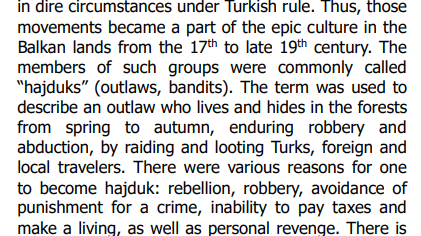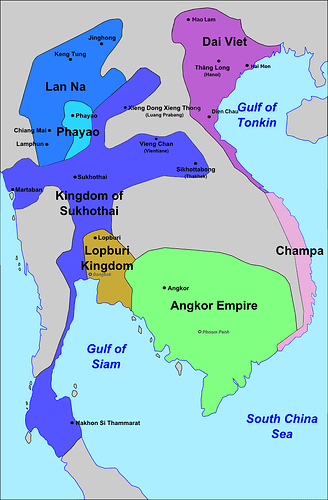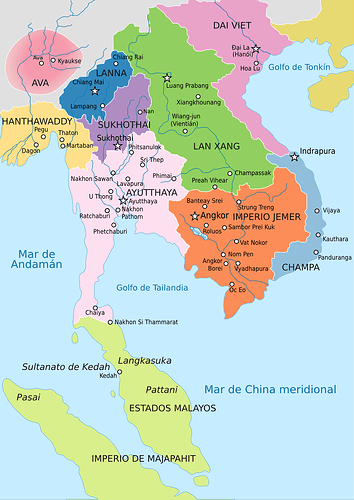Simple way to showcase this is tcs can train sheep or gathering from sheep gives gold.maybe even both combined.
TCS can train sheeps would be very interesting.
But I imagine also very hard to balance. Unless the sheep costs wood it’s not worth it, and why would a sheep cost wood? it’s an interesting idea but very hard to balance.
Gathering from sheep giving gold is not useful in the early game, and by the time it would be useful you run out of sheeps.
Perhaps something like can garrison Mills with herdable animals to produce food and gold. Except they produce less food than Gurjaras. The issue with that would be a weak early game since they need the food in early game.
What about giving fortified church to a sourh-slavic Balkan civ (Serbian)?
It would look out of place with the rest of the eastern buildings.
What if it cost food?
LOL? What is Balkan Terror? Most cringe shite I heard for a long time.
All that you write here shows me that you either 1. have no clue about the Serbian civilization, or 2. that you are too game-focused to propose something that is so far away from accurate regarding what history tells us.
Serbs should by all means be a Infantry and Cavalry civ, they had no particular experience with laying siege, as they were the ones being besieged multiple times, I have no idea why they should excel in siege. And neither do you. The tech name just screams cringe, “Balkan Terror”.
Tower cost is a good point as they should be a defensive civ. Much like the Georgians or Byzantines.
Something like the slavs for Castles, but extend to walls and gates as well, some of the stone cost replaced by wood.
Serbs had a pretty advanced industry of both lumber and minerals back in the days, meaning they should by no means miss the two-man-saw. Some bonus to mining as well, like longer lasting gold or stone perhaps.
Why should they miss treadmill crane, heated shot, bombard tower and architecture? All history tells us is that they were a very good defensive, but also offensive civ.
I have no problem with the worst Siege workshop in the game really. So I oppose you there too.
Dock: The Serbs did not have too much access to water during the history. So missing fast fire ship and shipwright but apart from that a fully upgraded dock? Nahh. Sounds stupid to me.
-Stable: Missing husbandry. Why? You say it is a “cavalry” civ and you want to remove husbandry?
-Monastery: Missing block printing, they kinda adopted to it very early, so remove something else from the Monastery, but not Block printing.
Your ideas are awful in short. And have really no relevance to history or the civilization in question.
Kinda obvious he has no clue about history when the UU is this.
Unique unit:
-Heavy infantry with a mask and armed with a morning star, which allows him an area attack
What about the Hajduks? real life Robin Hoods from Serbia.
Yes, I think they will eventually arrive in some dlc…imagine that they put in a Persian campaign with a dlc in the Caucasus…so anything can be…
Yes, the same the Siamese had Sukhothai (1238-1438) and then Ayutthaya (1351-1767) so they could enter AoE 2 and AoE 3 calmly…
17th century that is AoE 3…
That’s true, it feels Eurocentric because of the units not because of the civilizations… in AoK there were half European civs (7) and half Asians (6)…
The same thing, it is a war that happened 25 years ago… Nagorno Karabakh happens now and its ongoing and yet we have DLC in the Caucasus…
Because they were used by Skanderbeg and in the Venetian-Ottoman Wars and in the Italian Wars…there is a reason they appear in AoE 3 as mercenaries…
Yes, at most you have Scandinavia (dividing the Vikings in Medieval Danes and Swedes) and the Balkans (finishing dividing the Slavs in Albanians,Croats,Serbs and Vlacs)…
Always freedom…
Too late, the Hadjuk is from the end of the 16th century to mid19th century, so no…
A hajduk (Hungarian: hajdúk, plural of hajdú) is a type of irregular infantry found in Central, Eastern, and parts of Southeast Europe from the late 16th to mid 19th centuries. They have reputations ranging from bandits to freedom fighters depending on time, place, and their enemies.
In the European lands of the Ottoman Empire, the term hajduk was used to describe bandits and brigands of the Balkans, while in Central Europe for the West Slavs, Hungarians, and Germans, and Eastern Europe for the Ukrainians, it was used to refer to outlaws who protected Christians against provocative actions by the Ottomans.[1]
By the 17th century they were firmly established in the Ottoman Balkans, owing to increased taxes, Christian victories against the Ottomans, and a general decline in security. Hajduk bands predominantly numbered one hundred men each, with a firm hierarchy under one leader. They targeted Ottoman representatives and rich people, mainly rich Turks, for plunder or punishment to oppressive Ottomans, or revenge or a combination of all.[1]
In Balkan folkloric tradition, the hajduk (hajduci or haiduci in the plural) is a romanticised hero figure who steals from, and leads his fighters into battle against, the Ottoman authorities.[2] They are comparable to the English legendary Robin Hood and his merry men, who stole from the rich (who as in the case of the hajduk happened to also be foreign occupiers) and gave to the poor, while defying seemingly unjust laws and authority.[citation needed]
People that helped hajduks were called jataks. Jataks lived in villages and towns and provided food and shelter for hajduks. In return, hajduks would give them part of the loot.
The hajduk of the 17th, 18th and 19th centuries commonly were as much guerrilla fighters against the Ottoman rule as they were bandits and highwaymen who preyed not only on Ottomans and their local representatives, but also on local merchants and travellers. As such, the term could also refer to any robber and carry a negative connotation.
Hajduks were typical bandits and brigands who inhabited much of the Balkans during the Ottoman occupation of the 17th through 19th centuries. They occasionally served as mercenaries to the nearby Habsburgs, especially as part of the Military Frontier by the Ottoman border. Hajduk activity was predominantly motivated by the harsh taxes and religious persecution carried out under the Ottoman leaders, and as such, their targets were mostly Ottoman authority figures and aristocrats that benefited from their policies. This Robin Hood-style morality contributed to the romanticization of Hajduks as Christian freedom fighters battling Ottoman oppression. Despite their guerrilla-style combat tactics, bands of Hajduks adhered to a hierarchical system. The Serbian leader Karađorđe spent his early military career as a Hajduk and later applied his experience while spearheading the First Serbian Uprising against the Ottomans
Ok, yeah, it’s also in AoE3.
Shame, it was a unit very representative of Serbia.
Yes, that’s why… I don’t think they’ll put it in AoE 2, they’ll put another more medieval Serbian unit there…
Dont we have other overlapping units between aoe2 and aoe3?
Yes, but not so late…jaguar warrior, Conquistador, organ gun, caravel, Hussite wagon, winged husar, Urumi and so on…mainly units from the 15th and 16th centuries…
So did Byzantines and Spanish
If anyone can be bothered to read all of this maybe there’s evidence of Hajduks before the 16th century, Wikipedia isn’t the most accurate source out there.
All the eastern european factions lithuanians slavs magyars bulgarians cumans have cavalry uus so its only fitting a romanian faction should also get a cavalry uu to keep with the theme.

Your document clearly says the term originated after 17th century.
That is, Hadjuk outside…
There’s no shortage of cavalry units for a romanian faction, and being between the western nations and the Tattars, the romanian units show a mix of east and west.
Viteji (melee & range heavy cav) → Literally “Brave Men”. Viteji form a versatile corps of cavalry in the armies of the Romanian principalities. Their name means “brave ones” and they form part of a social strata that has gained lands and property through bravery in warfare. The viteji are therefore, as expected, among the most resolute and brave warriors a ruler could ask for. Like many elements of Romanian cavalry, the Viteji show influences both from the East and West, and their style of warfare imitates that of Cuman or Tatar armored horse archers, or that of Ottoman spahis. By their nature they are very versatile cavalry. In battle, the voievod would use these troops to counter the enemy’s cavalry flanks, either by engaging light cavalry in melee or harassing and exhausting heavy cavalry in range, then providing the decisive charge into the enemy’s flanks.
Calarasi (melee & range light cav) → Literally “riders”. Călăraşi form a part of the “oastea cea mica” (small host) and are part of the “slujitorii” (servants of the lord). Their name implies they fight on horseback. These soldiers were given land in exchange for military service, and retained their land so long as they remained as a readily-available force for the voievod, and exclusively in the service of the voievod. They are lightly armored, comparable to their curteni, and wield a composite bow. They were a very successful military instrument, remaining a significant part of the Wallachian army up until 1600, and form a potent counter to other horse archers.
Curteni (lance & shield light cav) → Literally “men of the court”, these are the retainers of the boieri, whom he takes into battle on horseback. Historically, they acted as a small mounted detachment under the direct command of a boier. They are not as competent as the viteji, nor as fast as the calarasi, but given the tradition of light cavalry in Wallachian armies, they are form a versatile screen for the calarasi. Their armor is very light, though this aids in their speed. They wield a spear or a lance in battle, omitting the benefit of a ranged weapon in favor of a large shield. They can perform devastating charges repeatedly due to their light equipment, but should not be expected to hold off a well-armed opponent.
Nemesi (lance & shield heavy cav) → The equivalent of the Wallachian Viteji but armed with spears instead of swords. This will be the strongest cavalry unit before the Boyars and the Princely Bodyguard.
Princely Bodyguard (heavy cavalry) → The Voievod of Wallachia keeps at his side a bodyguard of warriors paid from his own coffers, either consisting of native troops or mercenaries. Only the most loyal boiers, often those serving on the princely court, were entrusted with protecting the voievod. These men are equipped with the finest arms and armor money can buy, often with platemail bought from Venice or other Italian cities. It was even said in a chronicle that the Wallachian voievod Vlaicu bought 10,000 suits of Venetian plate armor in anticipation of warfare against the Hungarians. These form the elite of Wallachian heavy cavalry.
Wallachian Boyars → The boieri form the elite of Wallachian society and Wallachia’s heavy cavalry. They are the Wallachian nobles, who own vast swathes of land and rule over dependent peasants. Dressed in heavy armor, atop powerful mounts, and fighting in a style reminiscent of Western knights, they are a powerful force on the battlefield. The boieri however, are very accustomed to the game of political intrigue, and it is a telling fact that most of the Wallachian princes died of Wallachian swords and assassination than of old age, or on the field of battle. It is more telling that 20 princes were quickly cycled onto the Wallachian throne from 1418 to 1456, averaging to short and ineffective two-year reigns. The state of chaos caused by the boieri during this time was so great that when Vlad III the Impaler came to power he immediately had many of then killed (some of whom had actually assassinated his father and his older brother Mircea), deposed others from the princely council (replacing them with obscure or foreign nobles) and tried to promote the land-owning Mosneni as a counter-weight against them. Even so, the Boiars would rebound after Vlad III’s death, becoming a powerful force. If a voievod can keep them satisfied and loyal, the boieri will form a decisive force on the battlefield and a much-needed unit of heavy, melee-based cavalry.
Portar (armored pikemen) → Literally “gatekeeper”, the Portars are heavily armored pikemen. The Romanian principalities relied mainly on hit and run tactics with light cavalry and archer units so the Portar were a valueable defensive unit.
And the Boyar should be made into a regional unit replacing Paladin for Slavs (Ruthenians), Lithuanians, Romanians and Bulgarians.
Hajduks can be a UT something like trash units generating gold per kill?

